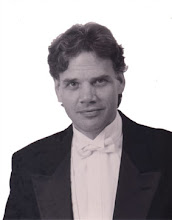The opening to "The Spheres" by Ola Gjeilo, slowly reveals a simple series of rich minor chords. Splitting the ensemble into two choirs, Gleilo overlaps the entrance of each chord with the next, which blurs the harmonies. The gentle, unaccented entrances discourage the perception of a sense of pulse, of groundedness, and encourage the sense that the vocal sounds are floating in space as the title suggests. The effect is rather like that of a written-in "reverb" -- or you might imagine that the composer is playing the choir like a piano with the sustain pedal held down. Only at the very end of the piece do we hear the opening material presented with a clear pulse, sung by the entire ensemble together, with a full sound, as if this ethereal music has now been brought down to earth, into the human realm.
The overall form that Gjeilo creates is something like a reverse variation: the varied form appears first, and only at the end do we hear the theme clearly stated. I've been meditating on how basic and powerful the idea of variation is. To vary something is to change it, but change is only part of what happens in variation. If something is to be varied there must be some element, some attribute that is kept the same. In defining that unchanging attribute we contribute toward a deeper understanding of the theme. Each variation retains some essential attribute of the theme and in holding up those attributes, we are creating a sort of wordless analysis of the theme. When we hear the fughetta of the tenth Goldberg variation, or the inverted canon in variation fifteen, we hear musical structures that are rich and complex in their own right; only on reflection and with careful study do we realize that they project some essential kernel of the aria, the theme. If there were no connection whatsoever we couldn't really say that the theme was being varied. If the connection were to be too obvious, we would fault the composer for lack of invention. In the case of the Goldberg Variations, the invention is so rich, the connections so subtle, the musical structures so complex, that it as if the theme is an opened door that can lead almost anywhere.
This is such an obvious, obvious, basic concept, and it may be ridiculous to point it out, but I'm fixated on it: Variation is everywhere in nature. All of life on earth uses the same genetic code. It is not possible for one life form to leap to an entirely new one without a connecting link. It may be possible to produce music that is entirely, radically, completely new, devoid of any reference to any previous form of expression or known sound structure -- but it would probably not be perceived as human music. Mere change (something new with nothing retained of the old) is exceedingly rare. Variation -- keeping the wings, feathers, eyes, basic body structure, but changing the beak -- keeping the harmonic pattern but changing the surface texture and the tempo -- keeping the descending bass line, but transforming almost every other feature of the theme and building entirely new, bewilderingly complex structures over it -- variation is the very nub of life and of art.
